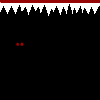This is kind of an April Fool's joke, in that I said I'll be releasing "THE GREATEST TAS EVER MADE!!" today. But other than that, this is a serious submission.
This is a videogame adaptation of Disney's five Winnie the Pooh films from 1966-1983. It's basically a boardgame... videogame! The whole strategy of the game is how good you can roll dice to satisfy a certain condition, whether that be landing on a certain space, or running away from another character who's trying to land on your space.
The objective in this movie was to get to the end (meet Christopher Robin) as fast as possible, and it involves playing through 5 different boards. There also exists a 100% category, where you would have to unlock all the storybooks and minigames in order to see an alternate ending and the credits.
How the dice works
Before I get into specifics, it should be noted that for the player, there is absolutely no RNG in the dice rolls (contrary to what I thought before making the TAS). Instead, it works as follows: when there is another AI playing on your board (as in the case of boards one, three, and five), the dice will give you a 1 on the first three frames you can press A to stop the dice, a 2 on the next three frames, a 3 on the next three, and so forth. After 6 runs its course, the cycle repeats. When it becomes your turn again, the dice will always start the sequence again at 1.
For the AI, the number that is rolled is purely RNG with no discernible patterns as far as I can tell.
For boards with no other AI, the first turn follows the same rules as before. On subsequent turns, however, the dice actually continues from what the previous turn selected, being preceded by a 1 for one frame in all circumstances. For example, if you selected a 4 the first frame it appears your first turn, the next turn will start with a 1 for the first frame, a 4 for the next two, and then a 5 for the next three. Alternatively, if the first turn selects the 4 on it's third frame, the next turn will start with a 1 on the first frame, and go directly to a 5 for the next three. Rolling the 1 on the first frame of any turn will not advance the sequence previously described.
Board 1
When rolling to see who goes first, the fastest situation was Rabbit and I both rolling 1's, so by default... I go first?
The rest is just me getting six's and manipulating Rabbit to get 1's to finish in the fastest possible time.
Board 2
You have to land on 3 starred spaces, each at a different corner of the map. There's two ways to go: clockwise or counter-clockwise. Going clockwise happens to be the faster way because walking up/down a tile is 16 frames shorter than walking left/right a tile. There are actually several dice-roll combinations you can make which land on all the spaces. For instance, the first two turns could be 2 then 6, 3 then 5, or 4 then 4 (as it is in the movie), all which take the same amount of time. By the way, the puddles subtract the moves you have left by two each time you land on one. By getting a 5 on the second frame of my last three turns, I can get across them in minimal time.
Board 3
A simple, linear board where the goal is to land on the same space as Piglet. He begins 10 spaces ahead of you, which means I need to move 11 spaces between my two turns, as Piglet will move 1 forward on his. Rolling the 5 on my first turn instead of the 6 saved a few frames in manipulating Piglet to roll a 1.
Board 4
Puddles everywhere on this board!! So many in fact, landing on the spring-board thingy in this instance is actually faster than walking around.
Due to the manner the dice behaves without an AI, I'm able to get three 5's and a 6 on the second frame the dice is rolled. I get 1's on the first frame for turns where it is needed. And yes, that 1 dice roll at the end is necessary. There is no other combination of rolls that can save this sixth turn.
Board 5
To win this board, you have to avoid Tigger for ten turns.... but losing it in two turns is far faster. All that needs to happen is I get a 6 and Tigger gets a 6 and it's over. I went clockwise on this map because that turned out to be one frame faster than going counterclockwise (I have NO IDEA what attributed to that lol).
The game is so simple, I literally see nothing that can be improved. Even that being said, unless you owned and were fond of this game as a kid, I foresee few people voting "yes" on this submission, as nothing really interesting happens. I could probably do the 100% TAS which would involve actually playing some of the minigames, but it requires completely different routing. This was just an easy game I chose to familiarize myself with the TASing process (it is my first TAS after all!), but I have other TASes in the works that should prove more interesting.
Note: The movie file says this was made in Bizhawk 1.11.6, but I have confirmed it still plays fine in v1.12.0
Fog: Ok, so this was surprisingly a rather interesting submission to judge. On the surface, it looks rather straight-forward as a board game. However, in actuality, it's an interesting case scenario for future submissions. Let me explain:
This game has three possible endings, one for just getting to the end of the woods without care of winning each board along the way, another for winning all the boards, but not the mini-games, and the third for beating all boards and the mini-games. This run aims to complete the first ending, which means not all of the boards were won. When this ending is reached, there are no credits played. Instead, you just hop, skip, and jump your way through the woods with Christopher Robin forever, and ever. The credits are only available for the other two endings.
In this run, the first four boards are played optimally to win, with the last board used to lose as fast as possible to trigger the first ending. After doing a casual play-through of the game myself, I was able to lose every board and mini-game, and still receive the same ending as the one that was reached in this submission. To me, this signifies that the first ending is considered to be the bad ending, or a game over in some sense. If the final board was beaten optimally, then there wouldn't be an issue with the submission. However, to me, it doesn't actually complete the game. To get the ending with credits, the author states that it would take about an extra minute and a half of gameplay. A submission with that extra gameplay to get the credits would be much more fitting of a submission, and would likely be accepted for Vault without issue.
Rejecting for not completing the game.











